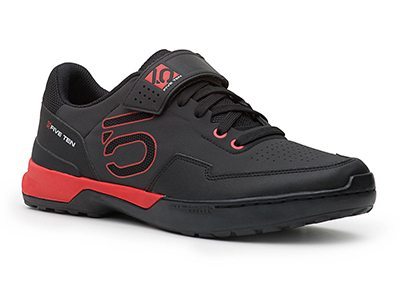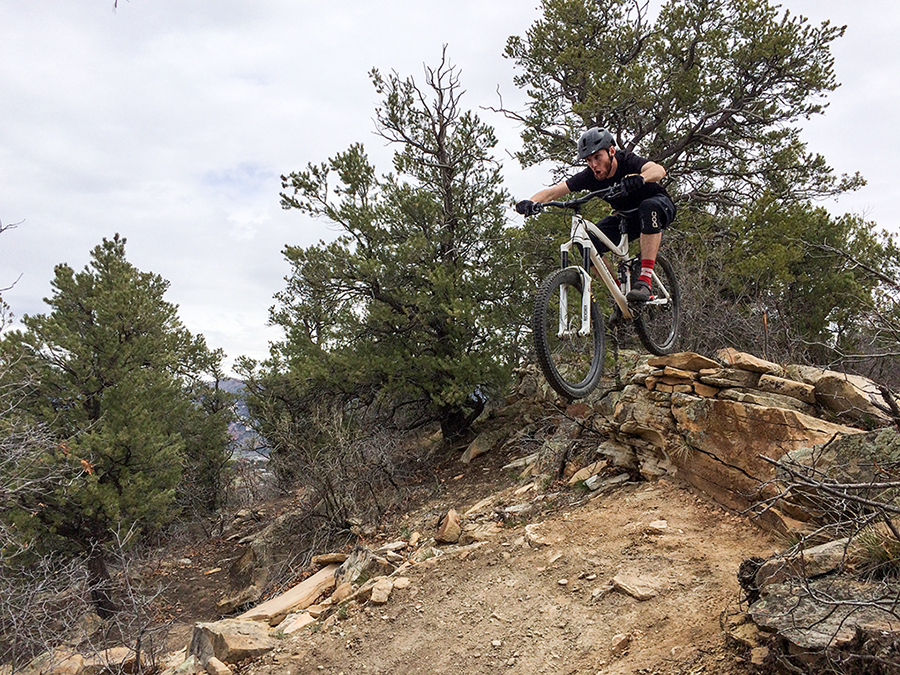
Five Ten Kestrel Lace
Blister’s Measured Weight: 434g each
Stated Features
- Stitched Stealth C4 rubber outsole
- Non-slip heel cup to reduce torsional flex
- Compression molded EVA midsole with nylon shank
- Polyurethane coated synthetic upper
- Velcro lace strap
MSRP: $150
Size Tested: 42.5
Reviewer: 5’10”; 143 lbs.
Test Locations: Colorado Springs, Durango, CO; Swiss Alps
Test Duration: 4 months
Introduction
Five Ten introduced the Kestrel in 2015 as a clipless shoe that would provide support and protection over long descents, pedal efficiently, and still be comfortable off the bike. The shoe was a big departure from what we were used to seeing from Five Ten, it wasn’t a beefy gravity shoe, and it also included a Boa tightening system instead of Velcro and laces.
Now, Five Ten is offering the Kestrel Lace, a new configuration of the shoe that mostly returns to Five Ten’s signature style. The majority of the construction stays the same, but as its name suggests, it comes with traditional laces instead of a Boa tightening system. Additionally, Five Ten made the Kestrel Lace slightly less stiff in order to make walking easier.
The Kestrel Lace is also available in a women’s version, which Blister’s Tasha Heilweil spent some time in. It offers less volume and a tighter fit in an effort to better accommodate smaller feet.
I set out to assess how well the Kestrel Lace performed in comparison to other popular enduro shoes and see how well the shoe held up over a few months of technical all-mountain riding and hike-a-bikes.
Construction
The Kestrel Lace uses the same synthetic construction as the original Kestrel, but is equipped with traditional laces and a Velcro strap instead of a Boa system. Additionally, Five Ten has replaced the carbon shank found in the original Kestrel with a nylon one. The brand claims that this change reduces stiffness by 15 percent. This should make walking a bit more comfortable.

The strap looks quite durable, as does the stitching around the metal bar that holds the strap. This is really good to see, as I’ve broken a pair of the Mavic Alpine XL’s by tearing this part of the shoe. The Mavic Alpine XL has a similar metal bar that acts a guide for the Velcro strap, and I actually ripped this bar completely out from its stitching at the end of a full season of riding.
It’s worth mentioning that the stitching that attaches the end of the strap to the outside of the Kestrel Lace looks pretty minimal. This part is less likely to undergo as much stress as the bar though, so I’m less worried about this area as a point of failure.
Five Ten uses polyurethane-coated synthetic material for the uppers, which should help keep moisture out of the shoe. Five Ten put a bit of mesh and a few pores to aid ventilation.
Five Ten uses its signature C4 Stealth rubber for the soles, but does without the extra grippy (but less durable) Mi6 rubber found on the original Kestrel. The sole is attached to the rest of the shoe via the red foam that surrounds the shoe. It looks like these components are simply glued together and might be susceptible to peeling, but only time will tell.
Aside from the foam, most of the outside of the shoe looks quite durable. The stitching looks solid, and the extra material around the toe provides added protection from flying rocks.
Fit
As is always the case with fit, these are simply my experiences in the shoe. My feet are pretty average in shape; different shaped feet may have different experiences.
The Kestrel Lace runs a little bit big and features a pretty spacious toebox. I’d advise going a half size down if you’re not already familiar with the how the brand fits or if you can’t try the shoe on anywhere.
The inclusion of laces instead of a Boa system meant that I could adjust tightness on my foot down the length of the shoe. As Noah mentioned in his review of the original Kestrel [link], the Boa system tightens the whole shoe at once. This can be a good thing if you like to adjust your shoes while on the bike, but it also means that you can’t loosen or tighten the shoe in a particular spot. I’m a fan of laces and shoes with multiple straps because they do allow this.
I felt like I could secure my foot nicely using the laces and the Velcro strap. The shoe also cups my heel nicely, which is great to see on such a low-cut shoe.
Performance
The Kestrel Lace’s stiff sole provides great pedaling efficiency. It doesn’t pedal like a purpose-built XC shoe, but it definitely holds its own among other shoes I’ve tried.
The shoe’s sole gave the entire ball of my foot a great connection with the bike. Paired with the wide platform of a Shimano DX pedal, my feet had ample support during compressions and flat landings. I had no trouble clipping out when I needed to.
Five Ten’s C4 Stealth Rubber compound also did its job nicely. Getting out of the pedal and dabbing in loose corners was easy, I could slam my foot right back onto the pedal without struggling to get traction on it again before I was clipped back in. Just for fun, I rode around on my buddy’s flat pedal-equipped bike, and found I could stick to the flat pedals without much trouble.
Although Five Ten has decreased the stiffness of the shank in the Kestrel Lace, the shoe hasn’t felt flimsy or flexy in any way. To the contrary, walking was actually a bit less comfortable than I expected. The Kestrel Lace is a bit ungainly when hiking up steep rock faces. Five Ten’s Stealth Rubber does a great job at gripping rocks, but the same characteristics that make the Kestrel Lace great at pedaling also keep the tread from fully conforming to a rock surface.
That said, I’m actually really happy with the balance Five Ten has struck in the Kestrel Lace’s construction. I prioritize being on the bike over being off it, and I’m only going to be hiking if I absolutely can’t clean a section of trail. Thus, the Kestrel Lace is a shoe that is biased very nicely for what I like to do – it prioritizes efficient pedaling and provides excellent support on the bike, but still gives me enough comfort and traction to get me through the necessary evil of an occasional hike-a-bike.
Ventilation
The Kestrel Lace has pretty minimal ventilation in the form of a bit of mesh and a few pores. Not surprisingly, it can get pretty swampy on hot days. Compared to most bike shoes, I felt like I was bringing a lot more stench back home for my housemates to enjoy.
That said, the lack of ventilation meant the shoes do well when hiking through snowy patches of trail and stream crossings. A lot of my initial riding in these shoes was done early in the season as the snow cleared in the Colorado front range, so I often found my feet feeling overheated when climbing up into the mountains, but then appreciated the shoes keeping my feet relatively dry and warm while shredding trails that dipped in and out of the snow line.
All in all, I think this tradeoff is pretty worth it for a lot of the riding I do, since it keeps my feet dry and makes for a more durable shoe.
NEXT: Durability, Comparisons, Etc.

Is the heal more comfortable and padded the the Kestrel Boa? I found the original shoe to be hard to put on, and then incredibly painful because of a flat, stiff heal cup. It seemed odd. Like someone had never seen feet before.
Pro-tip: If you get a pair of barrel nuts for $3 and shorten the laces (pass a lighter near the ends to avoid future fraying), you get a pretty bad ass quick lace system. I did this to my PI Seeks.